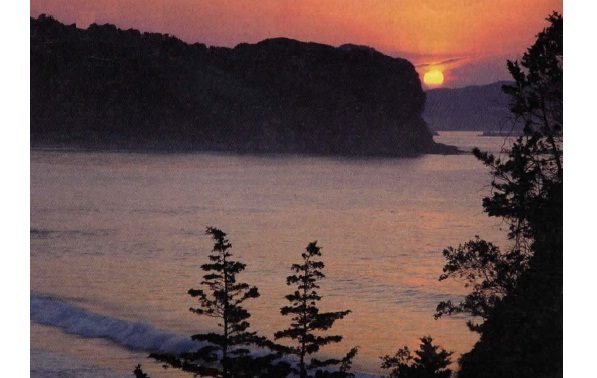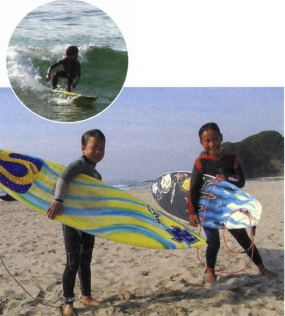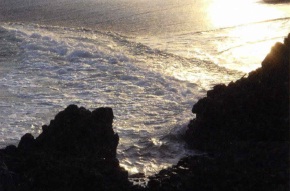by Brad Bennett
Summer is here and the temperature is right — for getting to the beach.
If you have a few days available, the Shimoda area of southern Izu is a favorite choice for foreigners who have discovered life beyond Roppongi. Even when the surf is flat, this area’s abundant nature and easygoing atmosphere offer a variety of quality outdoor experiences.
I first heard about the sandy beaches of southern Izu before learning it was the same place where diplomatic relations were established between Japan and the U.S. in 1854. There is ample history to admire in and around the town and the Shimoda Tourist Association has an office across the street from Shimoda Station. They can provide you with good maps and local information in English.
Note the local architecture on the tourist office building and ask about the 300-meter Namako-Kabe wall just a few minutes walk and worth a look. Other attractions near the station include an (expensive) ropeway up Mt. Nesugata that offers remarkable views at sunset, a “History Stroll” around the town and harbor area, including visits to Ryosoenji Temple, Shimoda Park and Shimoda Castle.
Exploring the coastline
If you have come for the sand and sea, the most popular beach is also the closest to Tokyo. Shirahama is the longest stretch of white sand in the area. It is also the most crowded since it has the best-quality waves and is a premiere windsurfing point when the wind howls. A Mecca for the younger crowd, where summertime services include a variety of beach rentals, and you can even get draft beers brought to your reclining beach chair and parasol.
There are many hotels and family-run inns that face the ocean here; the Pension Sakuraya, about five minutes from Shirahama beach, is fairly reasonable and has Western and Japanese rooms.
The next beach, Sotoura, sits amidst a fishing village with a few inns and pensions that overlook a quiet crescent bay. This is the best beach in the area for kids, where they can swim without fear of surfboards or an undertow.
The coastline becomes rocky and steep around Tsumekizaki and, unless you are arriving by car or bus, you might miss this small, picturesque cape. Following the coastline, there is a 2.8-kilometer ocean side walk with plenty of stairs and dramatic views. A recommended starting point is from Suzaki Kaigan (there is a bus stop here). Plan to take an hour to reach the lighthouse.
It should be noted that the distances between the beaches are out of comfortable walking range for most folks, and automobile traffic often comes to a grinding halt during busy summer weekends, so you may want to check the bus services and write down a few telephone numbers of local taxi operators before you leave die station area.
Continuing down the coast, Shimoda Park looks down on the harbor and is known for its historical monuments and hydrangea flowers during the rainy season in June. The Shimoda Aquarium is located in the harbor and is a decent option during bad weather. You can also take a harbor cruise on a replica of Commodore William Perry’s Black Ship.
About two kilometers south of Shimoda Station, Tatadohama and Iritahama are the next two beaches and are good for swimming and surfing. The Beach Side Condominium AZUL on Iritahama has reasonably-priced rooms facing the ocean overlooking this tranquil beach. There is no nightlife and few services, making it a nice alternative to bustling Shirahama.
Next, Kisami, Ohama and Toji are livelier with plenty of restaurants and activities, including surfboard and bodyboard rentals. This area has been a long-time favorite of the ex-pat community.
If you are hungry, I dare you to walk away from the Big American Breakfast at Marley’s Cafe next to Ohama Beach. The Ernest Guest House and Paradise Cafe just down the street offer a friendly atmosphere and have a lively bar in the evening. A bit further down the road, near Toji Beach, there are ocean view rooms at the Wave Guest House.
Other dining options in the area include: the Sunnyside Cafe, the small but very tasty South Cafe and the Spice Dog, a good place for curries and pasta, frequented by the local surf crowd and musicians.
It should be noted that the local beaches have lifeguards and designated surfing and swimming areas during the summer months and, although the waves are relatively small, the currents can be strong, so take care where you swim.
Sea kayaking
Well-known as a sea kayaking paradise, the southern Izu Peninsula has hidden coves and caves and offers plenty of coastline to explore. The southern Izu kayak resort Wonderful World, near Ohama Beach, can set you up with guide services, instructions, a boat and, if you or your group make plans ahead of time, a hand-tailored sea kayak tour set up by Mitsuo Ishibashi, the owner and operator who knows a thing or two about which way the local winds blow.
Izu hot springs
To get all the sand and sea salt out of your hair, a trip to one of the local hot springs is a must. Izu has many great onsen, and if you are staying in Shimoda, the Gin no Yu Kaikan at Shimogamo Onsen is a good choice. They have large, clean baths that they alternate for men and women. Try the lavender and orange baths, or plunge in the aloe bath to soothe your sunburn. Its ¥900 for two hours or ¥1,700 for the day. Facilities include indoor and outdoor baths, and a relaxation room with drinks and snacks. It’s about a 20-minute drive south of Shimoda (buses run from the station) and is situated just across the river from the Shimogamo Nettai Shokubutsuen (Tropical Plant Garden) and Tea Room.
Rendaji Onsen is located about three kilometers inland from Shimoda City (¥1,000). It’s a large and generally clean facility and good for groups. There are also local bathhouses from around ¥350 located in Shimoda Town. Check a town map for the locations and check the opening time, as many places close as early as 10 p.m.
So, pack your hiking boots, swim fins, grab your surfboard, your friends and family and hit the road for Shimoda.
Getting there
By train: A direct train (the Superview Odoriko, ¥11,100 round trip) runs hourly from Tokyo Station to Shimoda Station, while the Shinkansen runs from Tokyo to Atami, connecting with a local train to Shimoda (¥10,920 round trip). Both journeys are about two hours and 45 minutes. Alternatively, local trains from Tokyo via Atami (¥7,560 round trip) take about three and a half hours.
By car: Shimoda is located approximately 175 kilometers from Tokyo. It takes upwards of three hours along the Tomei Expressway, Odawara – Atsugi Highway and the Manazuru Highway, depending on traffic.
WHERE TO STAY
Sakuraya Pension tel: 0558-23-4470, web: izu-sakuraya.jp/english/
Azul Beach Side Condominium Hotel and Cafe Iritahama Beach tel: 0558-23-5454
Ernest Guest House tel: 0558-22-5880
Wave Guest House tel: 0558-23-6666
Tokyu Hotel tel: 0558-22-2411
OTHER USEFUL INFO
Shimoda Aquarium tel: 0558-22-3567
Shimoda Black Ship Tours, Izukyu Marine Pleasure Boat Wharf tel: 0558-22-1151
Southern Izu Kayak Resort Wonderful World tel/fax: 0558-23-0468 (Owner/Operator Mitsuo-san)
Shimoda Tourism Association tel: 0558-22-1531
Shimoda City Tourism Division tel: 0558-22-2211











